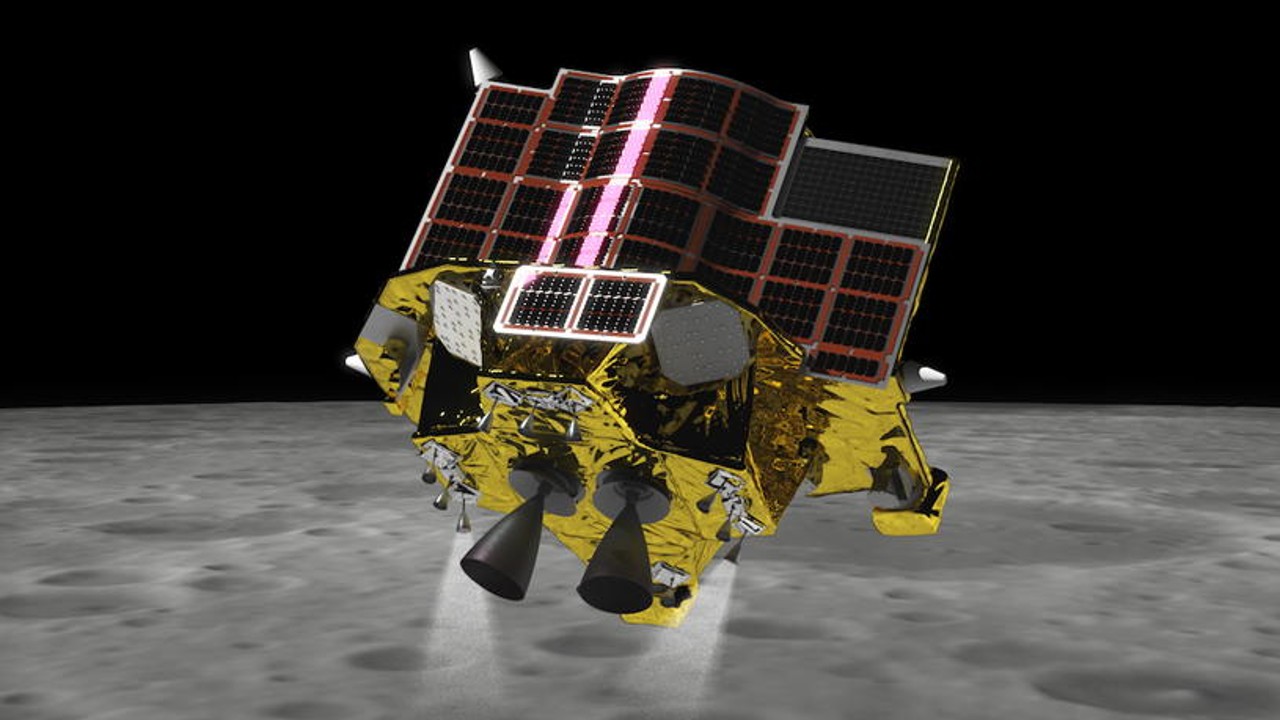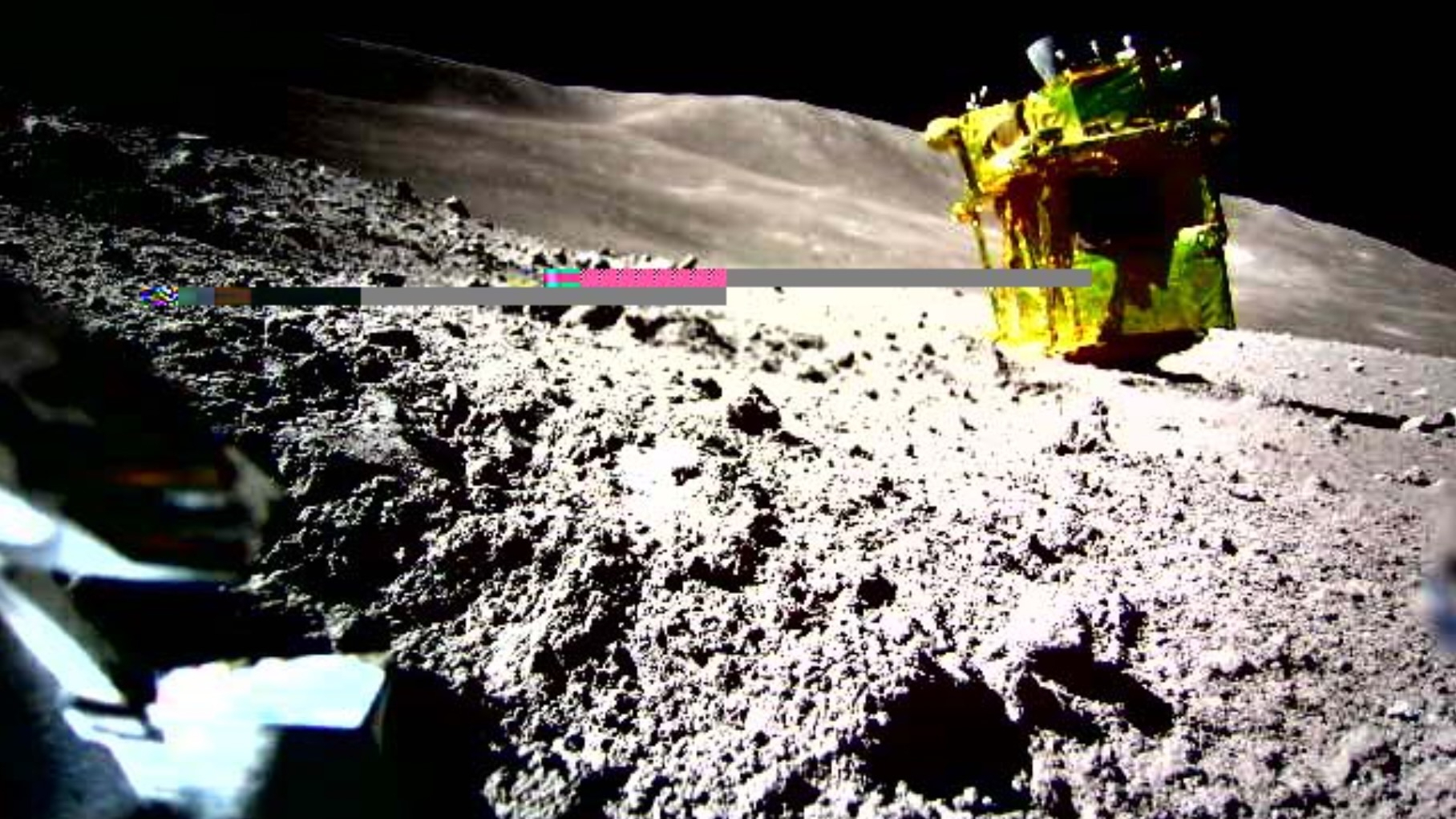
SLIM lander's precise 'moon sniper' tech will lend itself to future lunar missions
The technology that enabled SLIM's precision moon landing could assist future touchdowns by allowing spacecraft to land in relatively small areas amid rocky or uneven terrain.

This article was originally published at The Conversation. The publication contributed the article to Space.com's Expert Voices: Op-Ed & Insights.
Mariel Borowitz is an Associate Professor in the Sam Nunn School of International Affairs at the Georgia Institute of Technology and director of the Nunn School Program on International Affairs, Science, and Technology.
Japan landed its Smart Lander for Investigating the Moon, or SLIM, craft on the surface of the moon on Jan. 20, 2024. Despite a power issue with the lander, the event holds both political and technical importance. It's Japan's first lunar landing – making it only the fifth country in the world to successfully land on the moon. This is a significant achievement and solidifies Japan’' position as a leader in space technology.
While the craft landed successfully on the lunar surface and deployed its rovers, SLIM's solar cells were not functioning properly – meaning that the craft could likely only operate for a few hours.
I'm a scholar of international affairs who studies space. Like NASA and other space agencies, the Japan Aerospace Exploration Agency, or JAXA, wants to advance research and technology by demonstrating new techniques and collecting scientific data. The landing is also a part of something bigger – a growing global interest in lunar activity.
Related: The age of the private moon mission has begun
Precision technology
Japan's achievement isn't only symbolic – Japan is demonstrating a number of new technologies with the lander. The name, Smart Lander for Investigating the Moon, refers to the spacecraft's new precision-landing technology.
Get the Space.com Newsletter
Breaking space news, the latest updates on rocket launches, skywatching events and more!
This technology could assist future landings by allowing spacecraft to land in relatively small areas amid rocky or uneven terrain, rather than having to find large clearings. This ability will be particularly important in the future as countries focus on very specific areas of interest at the lunar south pole.
The lander also carried two small rovers, each of which will demonstrate a new technology for moving on the moon.
Lunar Excursion Vehicle 1 includes a camera, as well as scientific equipment, and uses a hopping mechanism to maneuver on the moon.
Lunar Excursion Vehicle 2, developed in a partnership among government, industry, and academia, is a sphere small enough to fit in the palm of your hand. Once on the surface, its two halves separate slightly, allowing it to roll around.
SLIM was designed to land within a 328-foot (100-meter) zone, far smaller than previous lunar landers which have had landing zones spanning multiple kilometers.
SLIM used a vision-based navigation system that took images of the lunar surface. Its system rapidly compared these images to crater patterns on lunar maps that JAXA developed with data from previous missions.
As countries identify areas that are most likely to hold useful resources, such as water in the form of ice, precision landing technology will allow agencies to avoid nearby hazards and reach these areas without incident.

International relations back on Earth
There is a geopolitical element to these activities. China, India and Japan – the three nations that have successfully landed on the moon since 2000 – engage in regional competition across a number of areas, including space. In addition to regional considerations, these accomplishments help to establish nations as leaders on a global scale – capable of something that few nations have ever done.
Japan's launch comes only six months after India's moon landing and just weeks after a failed attempt by a U.S. company, Astrobotic.
Both Russia and the private company iSpace made unsuccessful landing attempts in 2023. Japan's success in landing on the moon – even with solar panel issues shortening the timeline for the mission – demonstrates that JAXA is a major player in this global endeavor.
Despite recent setbacks, such as NASA announcing delays to its next Artemis mission, the U.S. is still a clear leader in space and lunar exploration. NASA has multiple spacecraft orbiting the moon right now, and it's already successfully launched the SLS rocket, which is capable of taking humans back to the moon.
NASA is developing very large and complex systems internally – like the Gateway space station, planned to orbit near the moon, and the infrastructure for the Artemis human moon missions. It's not uncommon for these large and complex efforts to experience some delays.
NASA has also turned many smaller-scale efforts over to commercial entities lately – like in the Commercial Lunar Payload Services program that supported Astrobotic's attempt. This is a new approach that involves some risk, but provides the opportunity for commercial innovation and growth of the lunar economy while giving NASA the ability to focus on big, complex aspects of the mission.
With regard to the moon, JAXA has partnered with the U.S. and taken on a very important component of the Artemis missions – the development of a pressurized lunar rover. This is a new and complex technology that will be critical to human missions on the moon in coming years.
Join our Space Forums to keep talking space on the latest missions, night sky and more! And if you have a news tip, correction or comment, let us know at: community@space.com.

Mariel Borowitz is an Associate Professor in the Sam Nunn School of International Affairs at the Georgia Institute of Technology and director of the Nunn School Program on International Affairs, Science, and Technology. Her research deals with international space policy issues, focusing particularly on global developments related to remote sensing satellites and challenges to space security and sustainability. Her book, “Open Space: The Global Effort for Open Access to Environmental Satellite Data," published by MIT Press, examines trends in the development of data sharing policies governing Earth observing satellites, as well as interactions with the growing commercial remote sensing sector. Her work has been published in Science, Strategic Studies Quarterly, Space Policy, Astropolitics, and New Space. Her research has been supported by grants from the National Science Foundation (NSF) and the National Aeronautics and Space Administration (NASA).
Dr. Borowitz completed a detail as a policy analyst for the Science Mission Directorate at NASA Headquarters in Washington, DC from 2016 to 2018. In 2022, she testified to the U.S. House of Representatives Subcommittee on Space and Aeronautics in a hearing titled, "Space Situational Awareness: Guiding the Transition to a Civil Capability."
Dr. Borowitz earned a PhD in Public Policy at the University of Maryland and a Masters degree in International Science and Technology Policy from the George Washington University. She has a Bachelor of Science degree in Aerospace Engineering from the Massachusetts Institute of Technology.
-
Cisventure Astronot How revolutionary are these technologies? How accurate was the previous most accurate lander? Are LEV-1 and LEV-2's methods of motion useful for anything other than micro-rovers? Are micro-rovers important in the larger picture?Reply -
fj.torres Reply
That you're asking those questions answers most of them. 😇Cisventure Astronot said:How revolutionary are these technologies? How accurate was the previous most accurate lander? Are LEV-1 and LEV-2's methods of motion useful for anything other than micro-rovers? Are micro-rovers important in the larger picture?
As for "revolutionary", well, IIRC most space landing systems rely on radar, lidar, or both and are mostly altitude-focused. Hitting a specific hundred meter area (say a landing circle or a drone at sea) without a homing beacon, from earth is a significant achievement. That it runs off image recognition (an AI sub-field) is also significant.
JAXA made some very smart choices on what tech to focus on. Bodes well for their contributions to ARTEMIS. -
Unclear Engineer I agree that JAXA has made some real progress in landing site approach technology. But the actual landing went awry, apparently because the optics got confused by the surface features during the final approach. So, there still seems to be a bit more to learn before we are going to have high success putting landers on a small flat spot in the middle of rough surfaces. Aiming for the lunar south pole, where the shadows are always long, is probably the toughest place to do an automated landing in an unfamiliar landscape with no "gps-like" system available.Reply -
Cisventure Astronot Reply
I thought it was an engine failure. You might be confusing it with Ingenuity. It says the following in this article:Unclear Engineer said:I agree that JAXA has made some real progress in landing site approach technology. But the actual landing went awry, apparently because the optics got confused by the surface features during the final approach. So, there still seems to be a bit more to learn before we are going to have high success putting landers on a small flat spot in the middle of rough surfaces. Aiming for the lunar south pole, where the shadows are always long, is probably the toughest place to do an automated landing in an unfamiliar landscape with no "gps-like" system available.
Japan Times reported that Sakai explained that JAXA scientists believe that SLIM's strangely orientated landing came about as a result of one of its two main engines stopping during the 30 seconds or so of touchdown and at an altitude of around 165 feet (50 meters) over the moon.
-
Unclear Engineer You might be right about me misremembering about the Ingenuity helicopter being confused by a smooth section and tipping so that its lower blade hit the surface. But, that is not what I was thinking with the JAXA lunar lander. I may be recalling some other speculation about SLIM's problem, but I can't find that now.Reply
I am wondering why a rocket motor would detach close to touchdown and end up "lying on the lunar surface". How was it determined that the nozzle did not dislodge on landing/impact?
Whatever, it was a step forward, but not a complete success with respect to the mission plan. If there had been humans aboard, they would be in a deadly situation at this point in their mission, with not way to lift-off. -
billslugg It was an engine problem:Reply
"Jaxa said the probe would probably have been within three to four metres of its intended landing site had one of its main engines not lost thrust in the final stages of its mission, causing a harder landing than anticipated. It had been aiming at a 100-metre-wide target."
https://www.theguardian.com/science/2024/jan/26/japan-slim-moon-sniper-probe-landing-upside-down









